#Advanced Battle Management System (ABMS) US
Explore tagged Tumblr posts
Text
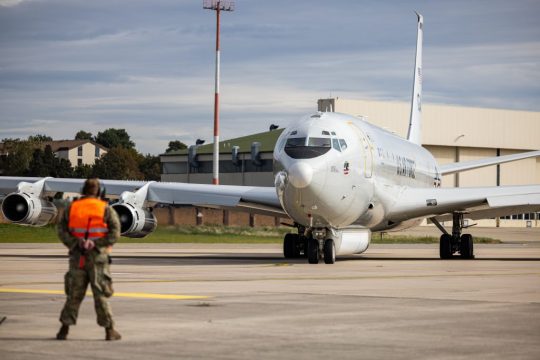
IMAGES: E-8 JSTARS flies on its last operational mission before retirement in November
Fernando Valduga By Fernando Valduga 10/05/2023 - 10:00am Military
A crew of aviators at Ramstein Air Base, Germany, carried out the last operational operation of the E-8C JSTARS aircraft on September 21, paving the way for the last plane in the fleet to be retired early next month.
Members of the 116ª Air Control Wing of the Georgia National Air Guard carried out the last of more than 14,000 JSTARS missions, which is used for direction, battle management and command and control.
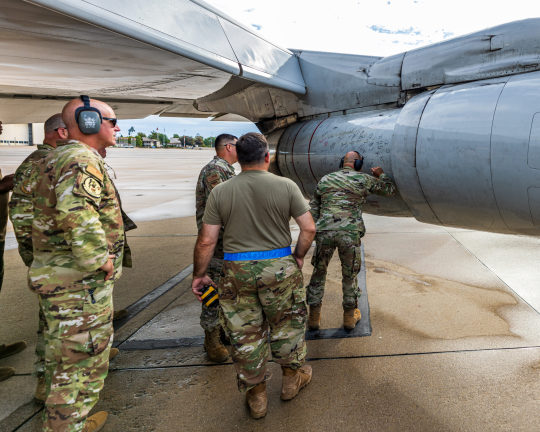
U.S. Airmen with the 116th Air Control Wing, Georgia Air National Guard, sign an engine of an E-8C Joint STARS for its last mission at Ramstein Air Force Base, Germany, Sept. 21, 2023. The JSTARS have been in service since 2002. (U.S. Air National Guard photo by Master Sgt. Jeff Rice)

"It's bittersweet," said Colonel Christopher Dunlap, commander of the 116ª Air Control Wing, in a statement. "I have been flying on this mission on this aircraft since the spring of 2003. There have been many changes over the years."
A 116º ACW spokesman said that two JSTARS aircraft now remain at Robins Air Base, Georgia. The provisional plan is to send the last one to the "Boneyard" (aircraft cemetery) at Davis-Monthan Air Base, Arizona, in the first week of November.
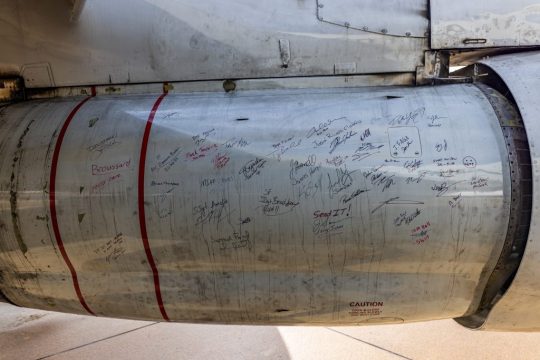
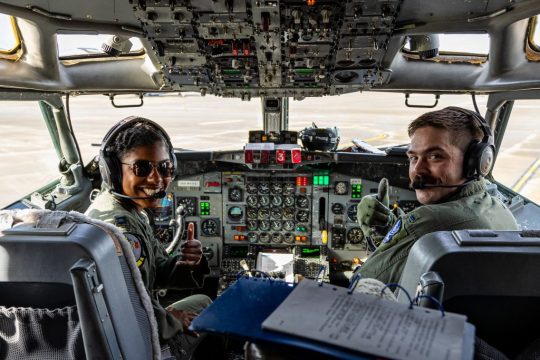
Until then, “the aircraft can be used locally for crew proficiency training, as needed,” the spokesman added.
Still, the final operational missions mark one of the last phases of life for the E-8. Mainly used for the indication of moving targets on the ground, JSTARS also served as a battle management platform. Its most distinctive feature is the canoe-shaped radome of about 9 meters in length under the front fuselage that houses a phased antenna of 8 meters in length and lateral appearance.
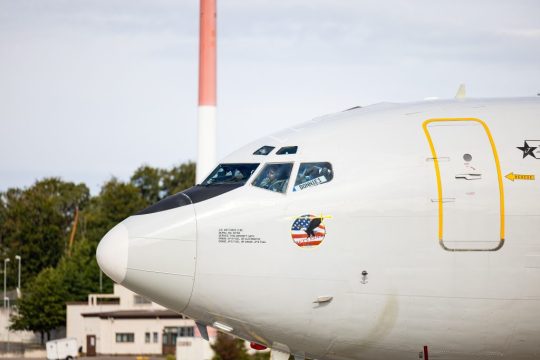
The aircraft first supported combat operations during the Desert Storm and played a key role in the contributions of the U.S. Air Force during the Global War on Terror. More recently, the E-8 carried out missions over Eastern Europe in preparation and immediately after the invasion of Ukraine by Russia in 2022.
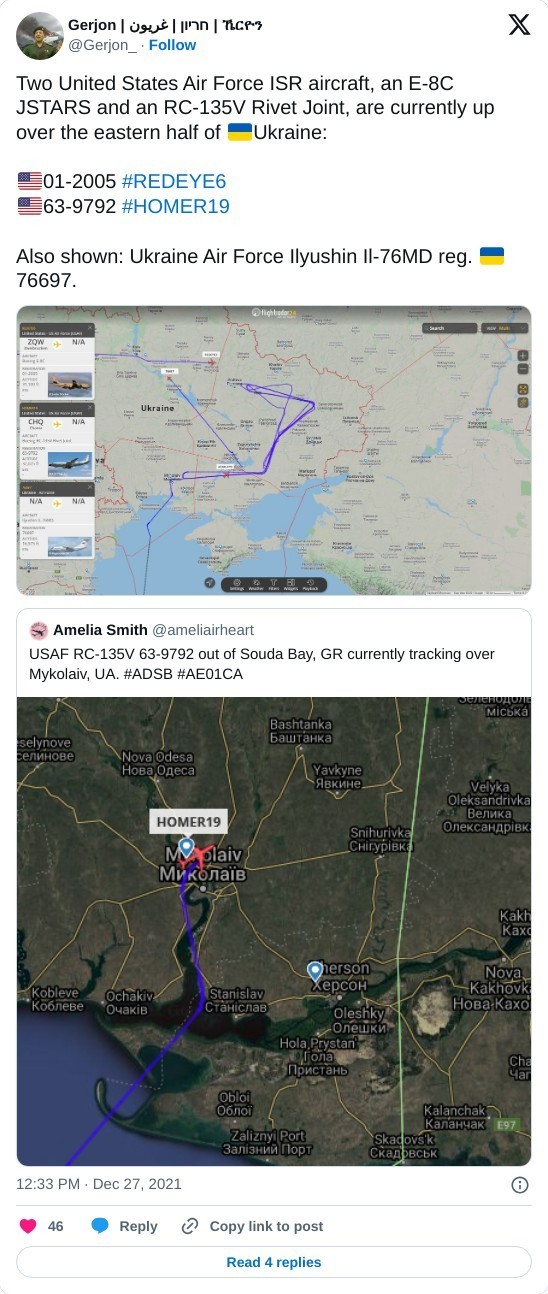
USAF has been planning to retire JSTARS for some time. In June 2021, service leaders announced their intention to cut Robins' aircraft, which has hosted them since 1996.
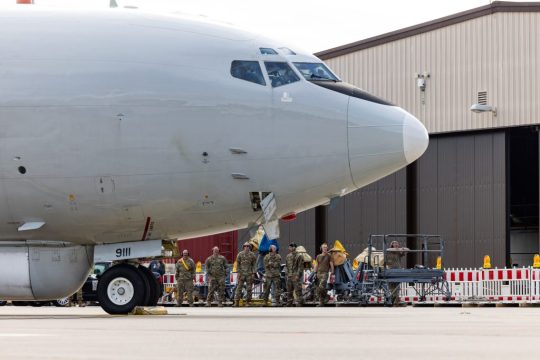
In its place, Robins is receiving a battle management control squad, an E-11A Battlefield Airborne Communication Node (BACN) squad, a Spectrum Warfare group and support units focused on the service's Advanced Battle Management System (ABMS).
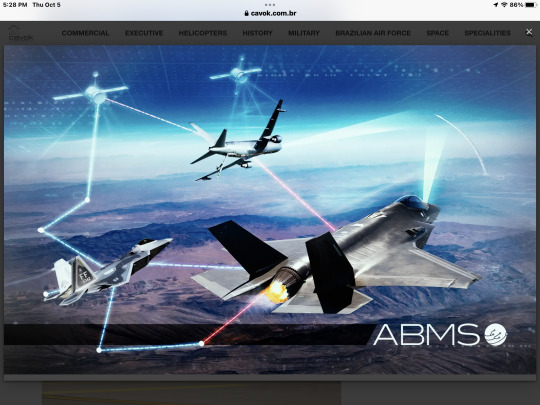
The first E-8 left Robins in February 2022. A month later, the USAF announced its intention to divest 12 of the 16 aircraft in fiscal years 2023 and 2024, and Congress accelerated the change by repealing a previous law that required the U.S. Air Force to maintain at least six E-8s.
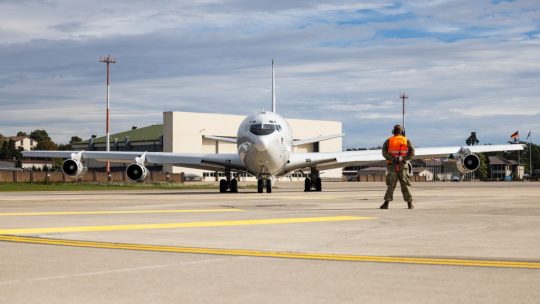
Last March, the USAF budget request revealed a plan to accelerate the divestment plan, with the entire fleet retiring by the end of the fiscal year 2024, which began on October 1º.
The leaders of the Armed Forces said that the U.S. Air Force needs to retire JSTARS because it would not survive in future combat with an advanced opponent like China. Instead, they want to invest in various information and guidance technologies, including space-based platforms.
In recent months, Robins has ended JSTARS operations, deactivating squads and conducting final flights. In June, the 461ª Air Control Wing in Active Service completed its last operational mission in Ramstein.
The 116º ACW spokesman said that before the final aircraft is officially retired, there will be “a private farewell celebration for the former students of the JSTARS program”.
Tags: Military AviationE-8C JSTARSUSAF - United States Air Force / U.S. Air Force
Sharing
tweet
Fernando Valduga
Fernando Valduga
Aviation photographer and pilot since 1992, he has participated in several events and air operations, such as Cruzex, AirVenture, Daytona Airshow and FIDAE. He has work published in specialized aviation magazines in Brazil and abroad. Uses Canon equipment during his photographic work throughout the world of aviation.
Related news
MILITARY
U.S. Marine Corps F-18 Hornet fighter pilots help locate crashed civilian aircraft
05/10/2023 - 08:20
MILITARY
HAL delivers the first LCA Tejas biplace to the Indian Air Force
04/10/2023 - 18:25
MILITARY
The F-35 fighter, the most expensive weapons program in the world, has just become more expensive
04/10/2023 - 08:11
MILITARY
Russia reactivates Beriev Be-12 seaplanes from the Cold War era to detect Ukrainian naval drones
03/10/2023 - 23:10
MILITARY
Meet the cockpit of the Saab F-39 Gripen, the most advanced fighter in Brazil
03/10/2023 - 19:14
MILITARY
RAF typhoons are sent to Poland for joint exercises before the Warsaw Security Forum
03/10/2023 - 16:00
I
11 notes
·
View notes
Text
Advanced Battle Management System field test brings all domains together during Second Onramp
Joint Base Andrews MD. (AFNS) Sep 03, 2020 The Department of the Air Force, in partnership with U.S. Northern Command and U.S. Space Command, held a second, more complex and rigorous field test Aug. 31 to Sept. 3 of an innovative and evolving approach to joint warfighting known as the Advanced Battle Management System. In the latest exercise, known as an "onramp," operators used ABMS to detect and defeat efforts to disrupt U.S. ope Full article>>
3 notes
·
View notes
Photo

New Communications Node for Battlefield
The US Air Force has been investing in Advanced Battle Management System (ABMS) as the foundational technology to connect its air, space and cyber assets together with platforms from the other military service. The first test of the ABMS was conducted in December, linking Air Force and Navy
https://i-hls.com/archives/98061
#communication node#tanker aircraft#US Air Force#Aircraft#Communications#Military#Networking#New Products#News#Resupply#Technology News#USA
1 note
·
View note
Text
Anduril among companies tapped to build the Air Force’s ‘internet of things’ for war
Palmer Luckey’s young defense company has been selected by the Air Force for work on a cutting-edge, multibillion dollar nervous system for war. Luckey announced the news that Anduril was one of the selected vendors for the project, known as the Advanced Battle Management System (ABMS), on his Twitter account Thursday.
Over the last four months, the Air Force named more than 50 different vendors who would work on developing the system, giving each the chance to receive from $1,000 to $950 million over the next five years. Amazon Web Services was also selected in the fresh round vendors, along with 16 other lesser known companies.
The vendor list includes a number of companies that aren’t the usual suspects in Department of Defense work, reflecting the “innovative acquisition strategy” intended to accelerate the timeline for the ambitious system.
As a three-year-old startup founded by the controversial Trump-booster who created Oculus, ushered in the dawn of consumer VR, and was eventually fired from Facebook, Anduril fits the bill.
“The goal of ABMS is to enable the Air Force and Space Force to operate together and as part of a joint team – connecting sensors, decision makers and weapons through a secure data network enabling rapid decision making and all-domain command and control,” according to an Air Force press release.
Assistant Secretary of the Air Force for Acquisition, Technology and Logistics Will Roper previously said that the ABMS competition would bring in “fresh blood,” particularly commercially-focused companies “that know a lot about data, that know a lot about machine learning and [artificial intelligence] and know a lot about analytics.”
Anduril has already picked up a surprising amount of federal work in its short lifespan. In June the Trump administration awarded Anduril with a contract to build a so-called virtual border wall comprised of its drones, sensor towers and AI software system — an opportunity that the company seemed custom-built for from its launch.
The ABMS project will ultimately fit into the Defense Department’s work on a system known as Joint All-Domain Command & Control or JADC2, a kind of meta software platform for warfare that connects all humans, devices, and equipment across the domains of air, land, sea, space and cyber and even the electromagnetic spectrum.
Per Luckey’s tweet, Anduril’s new contract is “for the maturation, demonstration and proliferation of capability across platforms and domains, leveraging open systems design, modern software and algorithm development in order to enable Joint All Domain Command and Control (JADC2).”
“It aims to link every ship, soldier, and jet, so that ground, air, sea, space, and cyber assets can share the exact same data and can be used almost interchangeably to take out targets, even in environments where communication is being heavily jammed or where adversaries have advanced air defenses,” Defense One explained in a piece on the project.
Working with the Department of Defense has been Anduril’s endgame from day one. The company opened that door through key hires, picking up contracts with Customs and Border Protection and the Marine Corps, and building out its small-scale proof of concept: a modular web of hardware and software that could talk to itself and operate autonomously.
Just months after launching in 2017, TechCrunch reported that Anduril was interested in “real-time battlefield awareness for soldiers on the ground and headquarters alike,” which sounds quite a bit like the company’s exploratory new defense work.
Anduril launches a smarter drone and picks up more money to build a virtual border wall
0 notes
Text
The Human-Robot Relationship Strengthens Further as Robot Dogs Join the US Air Force

Recently, the US military conducted one of its largest ever high-tech experiments as four-legged robot dogs scurried onto an airfield in the Mojave Desert. These resembled scenes from science-fiction movies, but the actual truth is that the robot-age is fast becoming our reality. This experiment was the second demonstration of the new Advanced Battle Management System (ABMS), an artificial…
View On WordPress
0 notes
Photo

US Air Force Hypervelocity Weapons System Test Hypervelocity weapons systems are tested in support of the Advanced Battle Management System (ABMS) Onramp at White Sands Missile Range, New Mexico on Aug.
0 notes
Text
Technology, Innovation and Modern War – Class 9 – Autonomy – Maynard Holliday
We just held our ninth session of our new national security class Technology, Innovation and Modern War. Joe Felter, Raj Shah and I designed a class to examine the new military systems, operational concepts and doctrines that will emerge from 21st century technologies – Space, Cyber, AI & Machine Learning and Autonomy.
Today’s topic was Autonomy and Modern War.
Catch up with the class by reading our summaries of the previous eight classes here.
Some of the readings for this class session included Directive 3000.09: Autonomy in Weapons Systems, U.S. Policy on Lethal Autonomous Weapon Systems, International Discussions Concerning Lethal Autonomous Weapon Systems, Joint All Domain Command and Control (JADC2), A New Joint Doctrine for an Era of Multi-Domain Operations, Six Ways the U.S. Isn’t Ready for Wars of the Future.
Autonomy and The Department of Defense Our last two class sessions focused on AI and the Joint Artificial Intelligence Center (the JAIC,) the DoD’s organization chartered to insert AI across the entire Department of Defense. In this class session Maynard Holliday of RAND describes the potential of autonomy in the DoD.
Maynard was the Senior Technical Advisor to the Undersecretary of Defense for Acquisition, Technology and Logistic during the previous Administration. There he provided the Secretary technical and programmatic analysis and advice on R&D, acquisition, and sustainment. He led analyses of commercial Independent Research and Development (IRAD) programs and helped establish the Department’s Defense Innovation Unit. And relevant to today’s class, he was the senior government advisor to the Defense Science Board’s 2015 Summer Study on Autonomy.
Today’s class session was helpful in differentiating between AI, robotics, autonomy and remotely operated systems. (Today, while drones are unmanned systems, they are not autonomous. They are remotely piloted/operated.)
I’ve extracted and paraphrased a few of Maynard’s key insights from his work on the Defense Science Board Autonomy study, and I urge you to read the entire transcript here and watch the video.
Autonomy Defined There are a lot of definitions of autonomy. However, the best definition came from the Defense Science Board. They said, to be autonomous a system must have the capability to independently compose and select among different courses of action to accomplish goals based on its knowledge and understanding of the world, itself, and the situation. They offered that there were two types of Autonomy:
Autonomy at Rest – systems that operate virtually, in software, and include planning and expert advisory systems. For example, in Cyber, where you have to react at machine speed
Autonomy in Motion – systems that have a presence in the physical world. These include robotics and autonomous vehicles, missiles and other kinetic effects
A few definitions:
AI are computer systems that can perform tasks that normally require human intelligence – sense, plan, adapt, and act, including the ability to automate vision, speech, decision-making, swarming, etc. – Provides the intelligence for Autonomy.
Robotics provides kinetic movement with sensors, actuators, etc., for Autonomy in Motion.
Intelligent systems combine both Autonomy at Rest and Motion with the application of AI to a particular problem or domain.
Why Does DoD Need Autonomy? Autonomy on the Battlefield Over the last decade, the DoD has adopted robotics and unmanned vehicle systems, but almost all are “dumb” – pre-programmed or remotely operated – rather than autonomous. Autonomous weapons and weapons platforms—aircraft, missiles, unmanned aerial systems (UAS), unmanned ground systems (UGS) and unmanned underwater systems (UUS) are the obvious applications.
Below is an illustration of a concept of operations of a battle space. You can think of this as the Taiwan Straits, or near the Korean Peninsula.
On the left you have a joint force; a carrier battle group, AWACS aircraft, satellite communications. On the right, aggressor forces in the orange bubbles are employing cyber threats, dynamic threats, denied GPS and comms (things we already see in the battlespace today.)
Another example: Adversaries have developed sophisticated anti-access/area denial (A2/AD) capabilities. In some of these environments human reaction time may be insufficient for survival.
Autonomy can increase the speed and accuracy of decision-making. Using Autonomy at Rest (cyber, electronic warfare,) as well as Autonomy in Motion, (drones, kinetic effects,) you can move faster than your adversaries can respond.
Autonomy Creates New Tactics in the Physical and Cyber Domains The combatant commanders asked the Science Board to assess how autonomy could improve their operations. The diagram below illustrates where autonomy is most valuable. For example, in row one, on the left, you don’t need autonomy when required decision speed is low. But as the required decision speed, complexity, volume of data and danger increases, the value of autonomy goes up. In the right column you see examples of where autonomy provides value.
The Defense Science Board studied several example scenarios.
Some of these recommendations were invested in immediately. One was the DARPA OFFSET (Offensive Swarm Enabled Tactics) program run by Tim Chung. He holds the record for holding a hundred swarms. And he took his expertise to DARPA to run a swarm challenge. Another DARPA investment was the Cyber Grand Challenge, to seed-fund systems able to search big data for indicators of Weapons of Mass Destruction (WMD) proliferation.
Can You Trust an Autonomous System? A question that gets asked by commanders and non-combatants alike is, “Can you trust an autonomous system? The autonomy study specifically identified the issue of trust as core to the department’s success in broader adoption of autonomy. Trust is established through the design and testing of an autonomous system and is essential to its effective operation. If troops in the field can’t trust that a system will operate as intended, they will not employ it. Operators must know that if a variation in operations occurs or the system fails in any way, it will respond appropriately or can be placed under human control.
DOD order 3000.09 says that a human has to be at the end of the kill chain for any autonomous system now.
Postscript – Autonomy on the Move A lot has happened since the 2015 Defense Science Board autonomy study. In 2018 the DoD stood up a dedicated group – the JAIC – the Joint Artificial Intelligence Center, (which we talked about in the last two classes here and here) to insert AI across the DoD.
After the wave of inflated expectations, deploying completely autonomous systems to handle complex unbounded problems are much harder to build than originally thought. (A proxy for this enthusiasm versus reality can be seen in the hype versus delivery of fully autonomous cars.)
That said, all U.S. military services are working to incorporate AI into semiautonomous and autonomous vehicles into what the Defense Science Board called Autonomy in Motion. This means adding autonomy to fighters, drones, ground vehicles, and ships. The goal is to use AI to sense the environment, recognize obstacles, fuse sensor data, plan navigation, and communicate with other vehicles. All the services have built prototype systems in their R&D organizations though none have been deployed operationally.
A few examples; The Air Force Research Lab has its Loyal Wingman and Skyborg programs. DARPA built swarm drones and ground systems in its OFFensive Swarm-Enabled Tactics (OFFSET) program.
The Navy is building Large and Medium Unmanned Surface Vessels based on development work done by the Strategic Capabilities Office (SCO). It’s called Ghost Fleet, and its Large Unmanned Surface Vessels development effort is called Overlord.
DARPA completed testing of the Anti-Submarine Warfare Continuous Trail Unmanned Vessel prototype, or “Sea Hunter,” in early 2018. The Navy is testing Unmanned Ships in the NOMARS (No Manning Required Ship) Program.
Future conflicts will require decisions to be made within minutes, or seconds compared with the current multiday process to analyze the operating environment and issue commands – in some cases autonomously. An example of Autonomy at Rest is tying all the sensors from all the military services together into a single network, which will be the JACD2 (Joint All-Domain Command and Control). (The Air Force version is called ABMS (Advanced Battle Management System).
The history of warfare has shown that as new technologies become available as weapons, they are first used like their predecessors. But ultimately the winners on the battlefield are the ones who develop new doctrine and new concepts of operations. The question is, which nation will be first to develop the Autonomous winning concepts of operation? Our challenge will be to rapidly test these in war games, simulations, and in experiments. Then take that feedback and learnings to iterate and refine the systems and concepts.
Finally, in the back of everyone’s mind is that while DOD order 3000.09 prescribes what machines will be allowed to do on their own, what happens when we encounter adversaries who employ autonomous weapons that don’t have our rules of engagement?
Read the entire transcript of Maynard Holliday’s talk here and watch the video below.
youtube
If you can’t see the video click here
Lessons Learned
Autonomy at Rest – systems that operate virtually, in software, and include planning and expert advisory systems
For example, Cyber, battle networks, anywhere you must react at machine speed
Autonomy in Motion – systems that have a presence in the physical world
Includes robotics and autonomous vehicles, missiles, drones
AI provides the intelligence for autonomy
Sense, plan, adapt, and act
Robotics provides the kinetic movement for autonomy
Sensors, actuators, UAV, USVs, etc.
Deploying completely autonomous systems to handle complex unbounded problems are much harder than originally thought
All U.S. military services are working to incorporate AI into semiautonomous and autonomous vehicles and networks
Ultimately the winner on the battlefield will be those who develop new doctrines and new concepts of operations
We’re seeing this emerge on battlefields today
0 notes
Text
Space Force thinking about NASA-style partnerships with private companies
https://sciencespies.com/space/space-force-thinking-about-nasa-style-partnerships-with-private-companies/
Space Force thinking about NASA-style partnerships with private companies
Col. Eric Felt: “The Space Force is going to be the most high tech of all of the services.”
WASHINGTON ��� The U.S. Space Force will be far smaller than the other military services but way more dependent on technology to do its job. While the Space Force will develop satellites and other technologies in-house, it also plans to follow the NASA playbook and team up with the private sector, said Col. Eric Felt, head of the Air Force Research Laboratory’s Space Vehicles Directorate.
Speaking at a SpaceNews online event June 4, Felt said NASA’s commercial crew program is “super exciting” and one that the Space Force can learn from.
The launch of a SpaceX Crew Dragon capsule on May 30 that took NASA astronauts to the International Space Station was the “culmination of perhaps the most successful private-public partnership of all times,” said Felt.
The Space Vehicles Directorate, located at Kirtland Air Force Base, New Mexico, is one of the organizations that Air Force Secretary Barbara Barrett agreed to transfer to the Space Force. Felt said his office will remain at its current location but approximately 700 people will be reassigned to the Space Force
“The Space Force is going to be the most high tech of all of the services,” said Felt.
Public-private partnerships like NASA’s commercial crew deals with SpaceX and Boeing have saved NASA billions of dollars and serve as a “powerful model” that the Defense Department could adopt, said Felt.
AFRL is applying the model albeit on a smaller scale, Felt said.
There are many commercial capabilities that can be used to meet military needs, he said. For space systems one way to do that is with a “hybrid architecture.” AFRL, for example, is conducting an experiment integrating data from 266 commercial remote sensing satellites with dedicated national satellites “to create a capability that’s much more robust and resilient than just any one piece of that all by itself.”
Another area suitable for public-private deals are data services to help the Space Force monitor every object in outer space, a discipline the U.S. military calls “space domain awareness.”
He noted that commercial companies now have powerful sensors and data analytics systems to track and investigate space objects.
AFRL, the Defense Innovation Unit and the Space Force’s Space and Missile Systems Center have been talking about setting up a “space commodities exchange,” for example, where space services could be traded like commodities, said Felt.
“It opens up the financial engine to optimize the price and the quality, where you establish certain quality standards for what you’re going to need,” he said. “The space domain awareness data might be a great example of the kinds of things that the Space Force could purchase through a space commodities exchange.”
The space commodities exchange is “one of the experimental business models that we’re working towards in the public private partnership area,” said Felt.
Opportunities with LEO constellations
Companies that are deploying broadband constellations in low Earth orbit also would be candidates for partnerships where satellites would host government communications payloads, he said.
AFRL next spring will launch an experimental cubesat equipped with a Link 16 encrypted radio frequency data link widely used on U.S. military and NATO aircraft and ground vehicles to share information
The Link 16 cubesat would serve as a communications network relay in space.
“This is something we’ve never been able to do before because our traditional communication satellites up in GEO [geostationary orbits] are too far away,” said Felt. “But if we have a proliferated LEO constellation then what we could do is put one of these Link 16 transponders onto each of these LEO satellites and you would basically have a Link 16 capability everywhere all the time.”
If the Link 16 experiment is successful, said Felt, “that’s a great opportunity for us to partner with these commercial companies that are putting up proliferated LEO constellations.” He said there are about 30,000 Link 16 radios across the U.S. military and NATO so “it would be super powerful to be able to have that kind of a transponder available everywhere because the signals can’t go through mountains. It’s a great capability to do from space.”
Another opportunity to work with LEO satellite operators is for the deployment of sensors for the Air Force Advanced Battle Management System, or ABMS. The program is looking at alternative platforms to integrate and analyze data during military operations.
The data collection and processing is currently done aboard large command-and-control airplanes that would be vulnerable flying over enemy territory, said Felt. “Those are ideal missions to also move to low Earth orbit and leverage some of the commercial capabilities that are out there.”
#Space
0 notes
Text

IMAGES: USAF retires the last E-8C JSTARS aircraft
Fernando Valduga By Fernando Valduga 11/16/2021 - 21:37in Military
It's official: the E-8C JSTARS aircraft has finished flying to the U.S. Air Force. The last Joint Surveillance Target Attack Radar System (JSTARS) aircraft left Moody Air Base, Georgia, on November 15.

The private ceremony at Robins Air Base was composed of former and current members of the JSTARS mission.
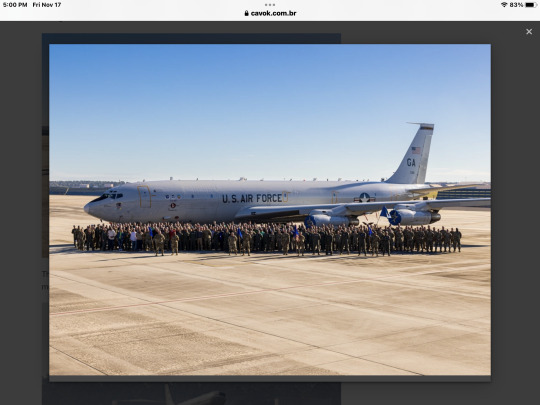
More than 800 alumni of the 116ª Air Control Wing, 461ª Air Control Wing and the former 93ª Air Control Wing joined local elected authorities and civic leaders to celebrate the 21 years of excellence that the JSTARS Team operated the E-8C aircraft.
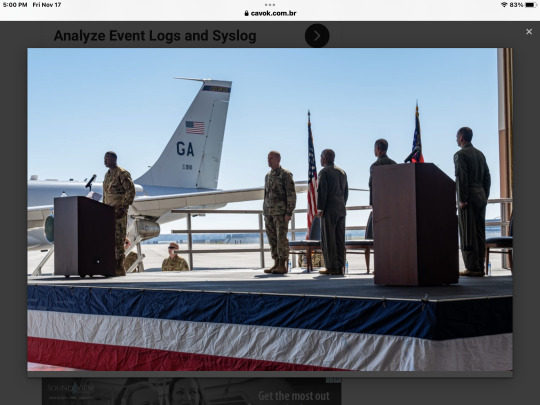
"JSTARS has been an important part of this community and the lives of everyone present for more than two decades; everyone here has a history and JSTARS has been a big part of our history for a long time," said Colonel Christopher Dunlap, commander of 116ª ACW. "We miss you that we say goodbye to the JSTARS mission. However, because of the professionalism and commitment of our aviators, we have received new cutting-edge missions that will keep our organization at the forefront in the coming decades."
The aircraft model entered service by the USAF for the first time in 1991, and entered service while still under development, to assist in Operation Desert Storm. The JSTARS Team has been deployed every day for the last 21 years, performing more than 14,259 operational sorties, totaling 141,169 flight hours in support of all combatant commands around the world.

JSTARS played a key role during the Global War on Terror and carried out missions over Eastern Europe in the period before and immediately after Russia's invasion of Ukraine in 2022.
“The role that E-8C JSTARS played for the joint community, our service and the local community has left a lasting mark on what success is like,” said Colonel Adam Shelton, commander of 461ª ACW. "Over a period of 21 years, the JSTARS team was on the air on combat flights equivalent to 16 years. The dedication of the former and current members of this joint team of the local community and industry laid the foundations as the transformation of Robins Air Base continues to advance."

The last operational outing of the E-8 took place at Ramstein Air Base in Germany on September 21. The last of the 17 aircraft will depart from Robins Air Base for Kelly Field, Texas, where it will serve as a training aircraft for future aviators.

Other JSTARS planes went to the "Boneyard" at Davis-Monthan Air Base, Arizona, but one remained in Georgia to become a static exhibition at the Aviation Museum.
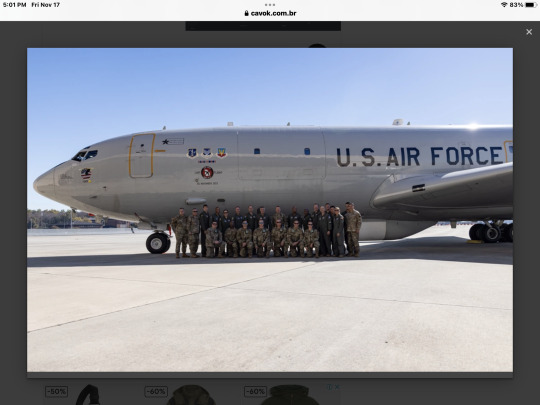
The aviators of the 116ª ACW and 461ª ACW have already started and will continue to work to establish four new missions at Robins Air Base.

In place of his JSTARS unit, Robins is receiving a battle management control squad, an E-11A Battlefield Airborne Communication Node (BACN) squad, a Spectrum Warfare group and support units focused on the service's Advanced Battle Management System (ABMS). The first E-11 arrived at the base in April.
Tags: Military AviationE-8C JSTARSUSAF - United States Air Force / U.S. Air Force
Sharing
tweet
Fernando Valduga
Fernando Valduga
Aviation photographer and pilot since 1992, has participated in several events and air operations, such as Cruzex, AirVenture, Dayton Airshow and FIDAE. He has work published in specialized aviation magazines in Brazil and abroad. Uses Canon equipment during his photographic work in the world of aviation.
Related news
Czech Air Force Gripen during Tiger Meet 2023. (Photo: Giovanni Colla)
MILITARY
IMAGES: Gripen Fighters at NATO's Tiger Meet 2023
16/11/2023 - 18:46
MILITARY
Commercial tanker refueled USAF fighters that were going to exercise in Singapore
16/11/2023 - 16:00
HELICOPTERS
Ukraine will receive a Black Hawk helicopter through crowdfunding
16/11/2023 - 12:30
AERONAUTICAL ACCIDENTS
Accident with two Indonesian Air Force Super Tucanos
16/11/2023 - 09:29
MILITARY
USAF leader reveals that secret X-plane program paved the way for NGAD
16/11/2023 - 08:47
MILITARY
IAI UAVs are playing a key role in Israel's ongoing operation against Hamas
15/11/2023 - 20:00
Client PortalClient PortalClient PortalClient PortalClient PortalClient PortalClient PortalClient PortalhomeMain PageEditorialsINFORMATIONeventsCooperateSpecialitiesadvertiseabout
Cavok Brazil - Digital Tchê Web Creation
Commercial
Executive
Helicopters
HISTORY
Military
Brazilian Air Force
Space
Specialities
Cavok Brazil - Digital Tchê Web Creation
5 notes
·
View notes
Text
Advanced Battle Management System field test brings all domains together during Second Onramp
Joint Base Andrews MD. (AFNS) Sep 03, 2020 The Department of the Air Force, in partnership with U.S. Northern Command and U.S. Space Command, held a second, more complex and rigorous field test Aug. 31 to Sept. 3 of an innovative and evolving approach to joint warfighting known as the Advanced Battle Management System. In the latest exercise, known as an "onramp," operators used ABMS to detect and defeat efforts to disrupt U.S. ope Full article>>
2 notes
·
View notes
Photo

Complete Picture of Battlefield
A new system dubbed as the Internet of Things for the US Air Force was recently tested. The Advanced Battle Management System (ABMS) was tested for the first time by the US Air Force. The system is a key technology the service is banking on to connect the information collected by various platforms
https://i-hls.com/archives/97449
#ABMS system#data fusion#US Air Force#Aircraft#C4I#Data Fusion#Military#New Products#News#Situational Awareness#Technology News#USA
0 notes
Text
Northrop Grumman helps U.S. Air Force integrate net-centric 5th-to-5th generation aircraft communications capabilities
The U.S. defense contractor Northrop Grumman has announced that it is rapidly working on developing and fielding a gatewayONE prototype, an open system enabling translation and communication across platforms, in support of the Advanced Battle Management family of Systems (ABMS).
Under the contract, awarded by the U.S. Air Force Life Cycle Management Center’s C3I & Networks Directorate, Northrop Grumman is providing engineering, management and technical assistance for the Air Force’s integration of net-centric 5th-to-5th generation aircraft communications capabilities and other platforms into a modular, open-architecture gateway. Testing of a flight-representative configuration will be conducted in a systems integration laboratory, on the ground, and in the air based on the four month operational demonstration pace envisioned by the Air Force Acquisition Lead, Dr. Will Roper and the Department of the Air Force Chief Architect, Preston Dunlap.
“We’re constantly advancing capabilities in networking and communications focused on large-scale modular, open architecture systems-of-systems solutions,” said Roshan Roeder, vice president, communications, airborne sensors and networks division, Northrop Grumman. “We are working closely with the Air Force to design and deliver to the field, advanced communications systems quickly and affordably.”
Work performed under this program will directly support live demonstrations of the Air Force’s developing Advanced Battle Management family of Systems. This capability could be used to network together the types of aircraft being developed through the Air Force’s Low-Cost Attritable Aircraft Technology initiative.
Northrop Grumman will integrate this capability — using its proven Freedom radio product line that can connect 5th-to-5th generation aircraft of a single type as well as 5th generation to 4th generation platforms — and via ABMS extend this to enable multiple 5th generation platform types to share and integrate data, helping make interoperability a reality. Freedom multifunction, software-defined radios are the heart of the F-22 integrated avionics suite and F-35 communications, navigation and identification system. Building upon investments, the company is developing affordable variants customized to fit multiple platforms.
Northrop Grumman solves the toughest problems in space, aeronautics, defense and cyberspace to meet the ever evolving needs of our customers worldwide. Our 90,000 employees define possible every day using science, technology and engineering to create and deliver advanced systems, products and services.
from Defence Blog
The U.S. defense contractor Northrop Grumman has announced that it is rapidly working on developing and fielding a gatewayONE prototype, an open system enabling translation and communication across platforms, in support of the Advanced Battle Management family of Systems (ABMS).
Under the contract, awarded by the U.S. Air Force Life Cycle Management Center’s C3I & Networks Directorate, Northrop Grumman is providing engineering, management and technical assistance for the Air Force’s integration of net-centric 5th-to-5th generation aircraft communications capabilities and other platforms into a modular, open-architecture gateway. Testing of a flight-representative configuration will be conducted in a systems integration laboratory, on the ground, and in the air based on the four month operational demonstration pace envisioned by the Air Force Acquisition Lead, Dr. Will Roper and the Department of the Air Force Chief Architect, Preston Dunlap.
“We’re constantly advancing capabilities in networking and communications focused on large-scale modular, open architecture systems-of-systems solutions,” said Roshan Roeder, vice president, communications, airborne sensors and networks division, Northrop Grumman. “We are working closely with the Air Force to design and deliver to the field, advanced communications systems quickly and affordably.”
Work performed under this program will directly support live demonstrations of the Air Force’s developing Advanced Battle Management family of Systems. This capability could be used to network together the types of aircraft being developed through the Air Force’s Low-Cost Attritable Aircraft Technology initiative.
Northrop Grumman will integrate this capability — using its proven Freedom radio product line that can connect 5th-to-5th generation aircraft of a single type as well as 5th generation to 4th generation platforms — and via ABMS extend this to enable multiple 5th generation platform types to share and integrate data, helping make interoperability a reality. Freedom multifunction, software-defined radios are the heart of the F-22 integrated avionics suite and F-35 communications, navigation and identification system. Building upon investments, the company is developing affordable variants customized to fit multiple platforms.
Northrop Grumman solves the toughest problems in space, aeronautics, defense and cyberspace to meet the ever evolving needs of our customers worldwide. Our 90,000 employees define possible every day using science, technology and engineering to create and deliver advanced systems, products and services.
via IFTTT
0 notes
Text
What the Game of Thrones Finale Can Teach Us About the Future of Marketing Attribution
PHOTO: HBO
Spoiler Alert: If you haven’t watched the Game of Thrones finale, this article isn’t for you.
The Game of Thrones series finale has me thinking about the future of marketing. Let’s be real: it’s not like there wasn’t room for some additional thought coming out of that last episode.
Here we go.
A new marketing world order is coming. No, it’s not Winter. And apparently it’s not democracy (sorry, Samwell).
What next-generation customer KPIs should we be looking at in this new age? Should they stand siloed by channel and source, like the North? Or should they represent the whole, unified and working together toward a Night Walker and tyrant-free future?
The answer has everything to do with the fact that we’re now able to know what we couldn’t before. In GoT, it was Bran’s foresight of a sharp, pointy thing that did the trick (OK, a few sharp, pointy things). In marketing, it’s a powerful new attribution model.
Your lead-focused approach is Daenerys Targaryen. Once the revered Mother of Dragons, in the end she just won’t win. Really, really won’t win.
Now we have Bran: Intelligent. Unbiased. Predictive. Does a whole lot of … processing.
I am talking, of course, about AI and machine learning, and specifically how those two things are rewriting how marketing can demonstrate and iterate on the most important metric in the modern marketing age: Contribution to revenue.
Related Article: How to Deliver Credible Marketing Pipeline Forecasts
What B2B Marketing Looks Like Today
This is the reality of a B2B marketing organization today:
Bigger buying committees (averaging seven people).
Longer sales cycles.
Increasing number of channels.
Relevant data across an average of 13 data sources (online and offline).
A whopping 10 to 20 tools in the average tech stack.
B2B marketing is more complex — and expensive — than ever. If you’re still focused primarily on leads, you’re in a losing battle to gain consistent and reliable momentum (Hello, first 70 minutes of Battle at Winterfell).
Think about it. You’re tracking all sorts of things: clicks, downloads, MQLs. You come in to meetings boasting higher metrics month after month. But: Your CEO/CRO doesn’t care about vanity metrics! Over time, if there is no clear connection between your efforts and an increase in revenue, your methods lose their trust. Ultimately, YOU lose their trust.
There’s a reason CMOs have the shortest tenure in the C-suite.
Related Article: Top CMO Challenges and Focus Areas for 2020
Chain-Based Attribution: Marketing That Wargs
Two KPIs that matter in the age of revenue marketing are your customer acquisition cost (CAC), and your customer lifetime value (LTV). Both show marketing velocity and are true indicators for success and failure over time.
You can only show that by taking a holistic approach to marketing. You’ll still be measuring metrics, of course. But the focus must shift to marketing comprising integrated data across sources, automated workflows, and a demonstrated understanding of how to align and build trust with sales.
Siloed data, disparate systems, lack of operations training, long and complex IT/BI projects, you name it. Marketers are drowning in data and starving for insights.
Best-in-class marketers are moving away from measuring touches, assigning weights and giving credit to channels. Those events in and of themselves don’t provide end-to-end account journeys. Revenue marketers start with the business outcome in mind and work backwards, analyzing Closed-Won/Closed-Lost.
This new attribution model is known as chain-based attribution (CBA).
Here’s how CBA compares with a traditional multi-touch attribution model:
Old/ Multi-Touch Attribution
New/ Chain-Based Attribution
Measures
Touches
Chains/conversion paths
Reports On
Credit
Contribution to revenue
Analytics
Output-based (clicks, etc)
Outcome-based (engagement, revenue)
Modeling
Heuristic/Business Rules (subject to human biases)
Probabilistic (using Markov Chains, based on Closed-Won, Closed-Lost conversion path analysis)
Campaign Data
Most solutions are native to Salesforce and require the use of Salesforce Campaigns and cost fields.
Powered by a B2B Customer Data Platform.
Supports both Salesforce and virtual campaigns, can pull cost data and calculate ROI using native connectors to Google Ads, LinkedIn, ABM ads, etc.
CRM Integration
When reporting on online hosted content with various URLs it requires “bucketed fields” in Salesforce, which has its limitations.
No Salesforce activities tracking.
Uses a standalone Campaign Manager to map campaigns between web analytics, CRM, and Marketing Automation software.
Auto-tracks Salesforce activities.
Identity Management
Requires email ID
Can match anonymous to known early in the buyer’s journey (using identity graph partners)
Use Cases
Small marketing spend, two to three channels, lead vs. account-based, heavy Salesforce use.
Bigger marketing spend across few channels, digital and social campaigns, need to match online and offline data with customizable attribution model and to count touchpoints across leads and contacts.
In addition, companies with a very content-centric approach would benefit from chain-based attribution.
Related Article: What Can You Do With a Customer Data Platform?
Customer Data Platform: The Bran We Could Have Used Before
Chain-based attribution, as described above, is available only because of advancements in technology, namely the customer data platforms (CDP). A CDP is designed specifically with marketing in mind, and is architected with machine learning and AI to integrate siloed data, create dashboards, and automate workflows in ways other tools in the martech stack cannot.
It’s incredibly powerful, and it is paving a new path forward for marketing and sales teams. Hi there, Bran.
Using automated machine learning to work faster and with smaller, less-than-perfect data sets, the CDP can reverse engineer Closed-Won/Closed-Lost account journeys and surface insights and recommendations on the right marketing mix of channels, touches, and cadence, based on the account characteristics.
Take the case of a Fortune 500 tech company that couldn’t find a way to determine the ROI of its multi-million dollar annual customer event. They didn’t know whether to cut back or increase spend going forward. With the switch to a CBA model they easily determined which attendees and engagements at the event were associated with closed deals, and made budget allocation decisions for the following year with confidence. The CDP also integrated event data into overall customer acquisition cost and customer lifetime value metrics.
A CDP is smarter, faster, unbiased and nets more accurate attribution results you can use to make better marketing decisions. Lead-focused marketing is going the way of the Iron Throne. It still stands today, but there’s a dragon in our midst with deep feels and a flame in its belly.
Where will you stand in the new marketing world order?
Raviv Turner is the CEO of CaliberMind, a B2B Marketing Analytics and Attribution Platform. He is an industry thought leader on marketing data & analytics, was selected as Inc Magazine’s ‘Top Tech Leaders to Watch’ and quoted by Forbes, Inc., and Huffington Post.
Source link
from Marketing Automation and Digital Marketing Blog http://amarketingautomation.com/what-the-game-of-thrones-finale-can-teach-us-about-the-future-of-marketing-attribution/
0 notes
Text
The approaching battle between ABM and advertising and marketing automation instruments – Advertising Land
For these of us who aren’t salespeople or entrepreneurs, account-based advertising and marketing (ABM) might appear to be one thing that ought to have been a part of advertising and marketing platforms all alongside.
In spite of everything, for those who’d prefer to get Massive Firm to turn into a brand new buyer of your merchandise, wouldn’t you select and pitch the account in addition to the person?
In fact, Gartner Managing VP and analyst Todd Berkowitz instructed me.
“The notion of ABM has been round for some time,” he stated, “beginning with very massive corporations their high 50 accounts” and attempting to determine how one can enhance their buyer base. Final month, he and Senior Director/analyst Noah Elkin launched their “Market Information for Account-Based mostly Platforms.” [Gartner account required.]
Historically, he stated, B2B gross sales was oriented towards key accounts to promote them extra product, whereas advertising and marketing was targeted on new buyer acquisition.
Many digital entrepreneurs initially discovered new enterprise with their digital instruments by focusing on and nurturing profiles of people. Though the people’ profiles contained firmographic information about their respective corporations, the advertising and marketing automation platforms have been largely set as much as deal with particular person leads.
“Everybody thought of [individual] leads,” Berkowitz stated, “as a result of every part was based mostly on folks [who] engaged with you, who got here to the website online.”
Now, new clever instruments permit entrepreneurs to focus on potential new accounts, at scale, whereas juggling interactions with people from that account.
As these ABM instruments evolve extra capabilities, a battle is brewing amongst these device suppliers and advertising and marketing automation platforms. And the outcomes of that battle can influence entrepreneurs’ future choices in device alternatives, buyer information administration and different areas.
Extra folks concerned in shopping for choices
A key advertising and marketing cause behind the rise of ABM in the previous few years, Berkowitz famous, is that “the variety of folks concerned within the shopping for course of retains going up,” he stated. This contains the variety of what he referred to as “assassins”: folks inside an organization who can kill a deal.
Why are there now extra folks concerned in shopping for choices?
One apparent cause, he identified, is that the extra advanced the deal — and complexity can correlate with the amount of cash concerned — the bigger the choice workforce. Since many buy choices contain expertise or different merchandise/providers which are used throughout a company, wide-scale buy-in is commonly required.
“If it’s a $2000 annual subscription,” he stated, “one particular person can determine.” However, if it’s one million {dollars}, he famous, there may be usually a committee.
And, since nearly all gross sales, advertising and marketing and different enterprise software program at the moment are supplied as cloud-based software-as-a-service, expertise buying choices have moved away from centralized IT departments and towards different departments, the place a departmental buy-in is commonly wanted.
The AI driver
Another excuse why ABM instruments have lately emerged is the supply of AI. First, AI was utilized by ABM to propel the automated collection of goal accounts by way of predictive analytics. More and more, it’s also driving the clever orchestration of nurturing and different advertising and marketing responses, based mostly on how the targets reply, their wants and profiles, the perceived hierarchy of people in that account, and so forth.
“One of many issues about ABM,” Berkowitz stated, is that “it takes a very long time to do properly and get it proper.”
In case you’re focusing on, say, 200 accounts as potential new company prospects, some people at these accounts will go to completely different pages at your website, some will obtain white papers, whereas others will reply to emails. Moreover, new information will emerge, for example, on the place new department places of work of the focused corporations are opening.
Responding to such a dynamically altering engagement and delivering the following greatest motion requires a coordinated, subtle and automated orchestration that’s solely now rising in ABM platforms, he stated.
Not a steady state of affairs
One would possibly suppose that the instruments within the ABM class would have been swallowed up by the massive advertising and marketing automation platforms. Whereas some ABM additions have been made to platforms like Marketo and Salesforce, Berkowitz stated, they don’t supply the capabilities of ABM-specific platforms like Engagio, Demandbase, Terminus, sixth Sense, Radius and RollWorks.
However, ABM instruments normally should not anticipated to be techniques of file the way in which a Salesforce buyer relationship administration system is, and no ABM instruments have a completely developed, native e mail functionality — a key want for account nurturing.
Because of this, ABM platforms all combine with advertising and marketing automation instruments, however Berkowitz predicts that this isn’t a steady state of affairs.
The approaching battle
ABM instruments are going to develop extra of the capabilities of promoting automation platforms — like subtle e mail options — he predicted, as a result of software program is all the time in search of aggressive differentiators and since the elevated use of AI will allow new ranges of dynamic response throughout channels.
With added capabilities, ABM instruments can then coordinate e mail interactions, orchestrate throughout channels and decide the following greatest response, along with predicting essentially the most responsive goal accounts, monitoring net visits and producing experiences. Briefly, they may have the ability to supply the important thing interplay capabilities wanted to pursue an account, missing solely a system of file for sustaining goal and buyer profiles.
By including capabilities, ABM instruments can get a much bigger share of entrepreneurs’ budgets. With these further features, it’s unlikely they’ll fall sufferer to entrepreneurs’ needs to scale back their toolset, Berkowitz stated, since many advertising and marketing departments have proven their willingness to handle “a large stack.”
As ABM instruments develop their resume, the Adobe/Marketos, Salesforces, Oracle Eloquas and B2B toolsets rising round Buyer Information Platforms are going to must determine whether or not to totally develop their ABM aspect, or to purchase an current ABM vendor.
It’s not clear but how the bigger advertising and marketing automation platforms will reply, Berkowitz stated, however it’s clear the battle is about.
This story first appeared on MarTech Right now. For extra on advertising and marketing expertise, click on right here.
About The Writer
Barry Levine covers advertising and marketing expertise for Third Door Media. Beforehand, he lined this area as a Senior Author for VentureBeat, and he has written about these and different tech topics for such publications as CMSWire and NewsFactor. He based and led the website online/unit at PBS station 13/WNET; labored as a web based Senior Producer/author for Viacom; created a profitable interactive sport, PLAY IT BY EAR: The First CD Recreation; based and led an impartial movie showcase, CENTER SCREEN, based mostly at Harvard and M.I.T.; and served over 5 years as a guide to the M.I.T. Media Lab. You’ll find him at LinkedIn, and on Twitter at xBarryLevine.
Supply hyperlink
source https://webart-studio.com/the-approaching-battle-between-abm-and-advertising-and-marketing-automation-instruments-advertising-land/
0 notes
Text
US Air Force Tests Launching Pallets of Missiles from C-17 Transport
US Air Force Tests Launching Pallets of Missiles from C-17 Transport
The U.S. Air Force Strategic Development Planning and Experimentation (SDPE) office successfully demonstrated the ability to command and control an experimental Palletized Munitions weapon system, while participating in the Air Force’s Advanced Battle Management Family of Systems (ABMS) Onramp #2 activities. The Palletized Munitions demonstration leveraged Multi Domain Operations initiatives and…
View On WordPress
0 notes
Text
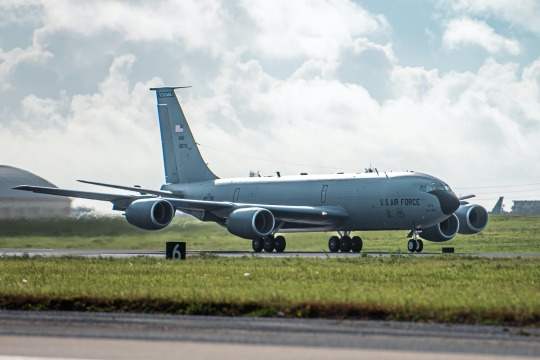
USAF adds Command and Control capability to the KC-135 aircraft
Fernando Valduga By Fernando Valduga 09/28/2023 - 16:00in Military
A Stratotanker KC-135 assigned to the 151ª Air Refueling Wing takes off during exercise Northern Edge 23-2 at Kadena Air Base, Japan. (Photo: U.S. Air Force / Senior Airman Sebastian Romawac)
During the recent Northern Edge 2023 exercise, the KC-135 Stratotanker was equipped with new command and control capabilities, marking a departure from its traditional 50-year function of providing fuel support for military aircraft during operations.
Equipped with the Tanker Intelligent Gateway (TIG) system from Collins Aerospace, an RTX company, the KC-135 demonstrated during this exercise its ability to connect different networks, inside and outside the line of sight. This Smart Gateway uses sensor data to make decisions.
Military sensors are getting smarter, but generating a lot of data. To deal with this, different military devices must be able to share information, even if they have not been designed to work together.
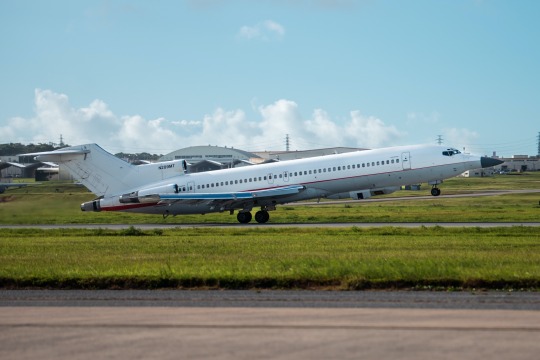
The Raytheon Multi-Program Testbed takes off during the Northern Edge 23-2 exercise at Kadena Air Base, Japan. (Photo: U.S. Air Force / Senior Airman Sebastian Romawac)
To solve this problem, the Intelligent Gateway system transforms disconnected platforms into connectivity access points for data passage. During the Northern Edge, for example, the Intelligent Gateway, combined with a command center and battle space control capability, demonstrated how the KC-135 could serve as a command and control node to conduct battle management and dynamic target selection.
This modified KC-135, provided by the Utah National Air Guard, flew alongside the Multi-Program Testbed, a modified Boeing 727 equipped with advanced sensors from Raytheon (also an RTX company) during the exercise. In this joint operation, the KC-135 transferred target designation data on simulated threats at the tactical boundary, showing its new command and control capabilities.
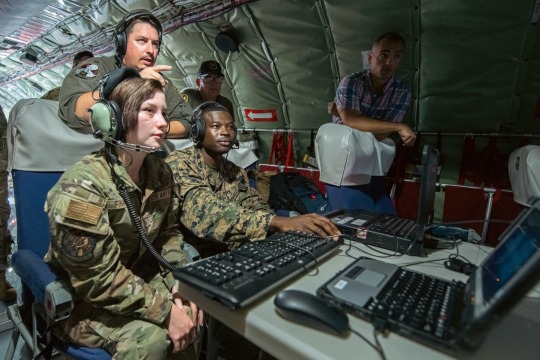
More than 500 OSS air battle managers joined a KC-135 test team to simulate combat and share data during Northern Edge 2023. (Photo: U.S. Air Force / Senior Airman Sebastian Romawac)
Major Mike Starley, director of the test detachment of the KC-135 National Guard National Guard Air Force Reserve Command Test Center, highlighted the importance of this advance, stating: "We have only a certain number of surveillance aircraft available, and in a theater as large as the Indo-Pacific, there will be many areas without command and control. However, we will always have a tanker plane present. Now we can make the most of all this available space and use the KC-135, which is already engaged in combat, for command and control."

RMT uses a combination of radar and electronic intelligence sensors to capture information about simulated threats that are then passed on to allied players for improved command and control.
The Multi-Program Testbed demonstrated the ability to collect intelligence data from multiple sources, called multi-INT, while demonstrates data synchronization and prioritization using artificial intelligence and machine learning. This simplified data analysis and improved situational awareness for military aircraft.

Intelligent Gateway connectivity combined with the Battlespace Command and Control Center air battle management hardware/software provides command and control capabilities for ABMs conducting a C2 distributed tactical experiment during NE 23-2. (Photo: U.S. Air Force / Senior Airman Sebastian Romawac)
The test platform contained advanced processing software called Nimbus Rush, along with AI-enabled machine-to-machine communications that prioritized multi-INT data and distributed it to various aircraft, including the KC-135 Stratotanker refuel and C-17 and C-130 transport aircraft. These data provided these aircraft with greater awareness of the simulated threats.
Tags: Military AviationBoeing KC-135 StratotankerNorthern EdgeUSAF - United States Air Force / U.S. Air Force
Sharing
tweet
Fernando Valduga
Fernando Valduga
Aviation photographer and pilot since 1992, he has participated in several events and air operations, such as Cruzex, AirVenture, Daytona Airshow and FIDAE. He has work published in specialized aviation magazines in Brazil and abroad. Uses Canon equipment during his photographic work throughout the world of aviation.
Related news
MILITARY
VIDEO: For the first time, BAE Systems/Malloy drone demonstrates torpedo launch
28/09/2023 - 14:00
MILITARY
VIDEOS: Polish Air Force aircraft practice takeoffs and landings on highways
09/28/2023 - 12:00
MILITARY
The German government's VIP transport A350s will receive IR missile self-protection system
09/28/2023 - 10:00
MILITARY
UAC delivers new batches of Su-57 and Su-35 fighters to the Russian Aerospace Forces
09/28/2023 - 08:36
MILITARY
Czech Republic approves purchase of F-35A fighters
27/09/2023 - 22:41
HELICOPTERS
Safran will participate in the U.S. Army FLRAA project
27/09/2023 - 16:00
5 notes
·
View notes